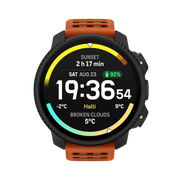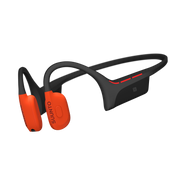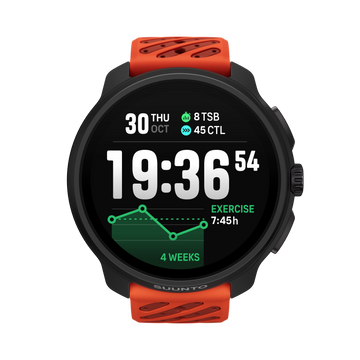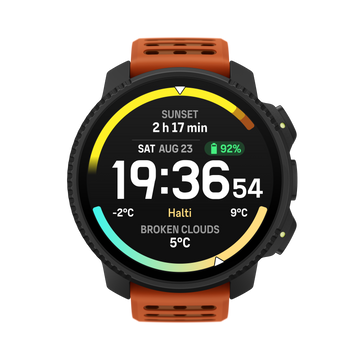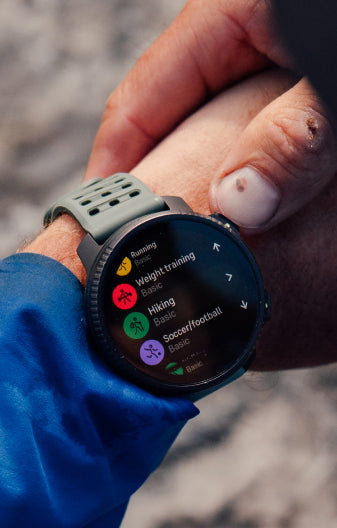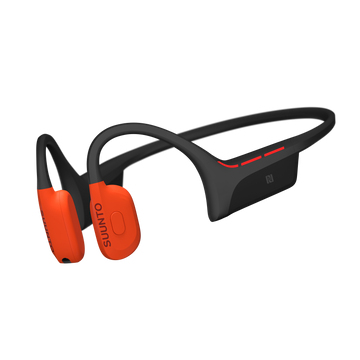

Suunto Blog
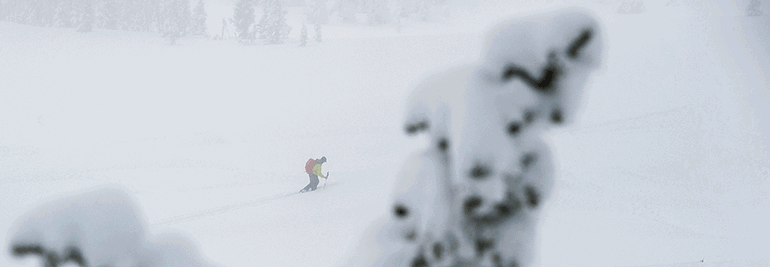
TUTORIAL TUESDAY: WHERE AM I? FINDING YOUR LOCATION WITH AN AMBIT
Figuring out where you are is fairly simple when you have a map, the visibility is good and you can identify a few landmarks. But when the going gets rough, the weather is against you and the sun sets, the task isn’t so simple any more. In this tutorial you will learn how your Ambit can help you to find your location.
The basics are simple: you can find your current position with a few clicks of the Ambit.
Choose: Navigation – Location – Current
To make sure you get the satellite fix as quickly as possible, remember to sync your Ambit regularly and keep it up to date.
Once you have found the GPS signal you will get your current location in geographic coordinates. The most common coordinate system in GPS devices is WGS84, which is also used by default in Suunto GPS watches.
Use the same coordinate system on your watch and map
If you need to give your exact location to someone in a rescue situation, WGS84 works. But when you start using a map and defining your location on it, you will need to make sure your GPS watch and the map use the same coordinate system. (To change your Ambit’s coordinate system go to General – Formats – Position format.)
Latitude/longitude is the coordinate system used in marine navigation and is common on topographical outdoor maps. Latitude lines run horizontally. The zero latitude is the Equator. Longitudes run vertically and the zero longitude runs through Greenwich, England. The latitude is normally the first number expressed in lat/long coordinate (for example 60°16'19" N 24°58’23’’ E).
WGS84, which uses latitudes/longitudes, is actually more than a coordinate system: it also includes a model of the globe that enables the use of GPS altimeters.
UTM is a grid coordinate system that is used on many outdoor maps. It divides the map into a perpendicular grid in which each of the squares are the same size anywhere on the map. This means the coordinate system is tied directly to a distance in meters.
This Norwegian map has both WGS84 (black) and UTM (blue) coordinates.
The black numbers on the sides of the map are degrees latitude; the numbers on the top and bottom of the map are degrees longitude. To determine your location on the map, draw a west to east line through the corresponding latitude and a south to north line through the corresponding longitude. The intersection of the two lines indicates your position.
The blue numbers are the northings and eastings of the UTM coordinate system. You can use them like the lat/log when finding your location on the map.
You can get support for your Suunto product at support
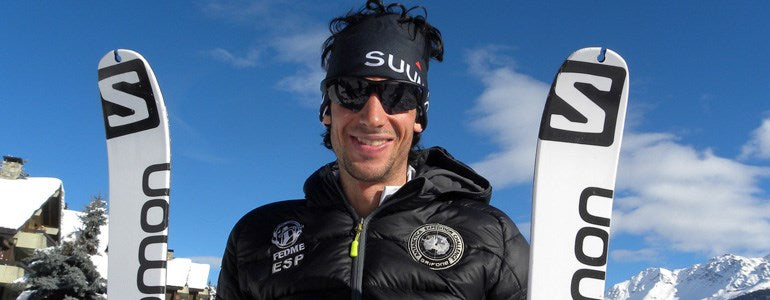
How to transition like Kilian
Every second counts in the world of skimo racing, and a quick changeover between uphill and downhill sections can make all the difference. For regular ski tourers, it's always an impressive sight to see how the pros do it in just a few seconds. Here, ski mountaineering world champion Kilian Jornet reveals his top tips for an efficient transition. And check the video below to see him in action.
1. Think ahead
As I arrive at the transition, I start to mentally prepare for both the transition and the downhill stretch of the race that will follow. Do I have any more uphill sections, or will this be the final run down? This is important as it determines how I remove and store my skins.
2. Get ready
A few meters before I reach the top, I open my suit and remove my pole straps, ready to lay them down on the floor as I enter the transition area.
See how Kilian does it.
3. Change modes
After putting my poles on the floor, I switch the boots to ski mode with both hands, and then twist the binding into the downhill position.
4. Skins off
If there are more uphill sections to come, I take the top of the skin in one hand before kicking my foot forward and ripping the skin off in one fluid motion. I fold the skin in half, tuck it in my suit and repeat the process with the second skin. If it’s the last downhill of the race I won’t need to use the skins again so I rip the skins off in quick succession and store them together in my suit.
5. Setting off
Lastly I zip up my suit, pick up my poles, check my heels are locked in and get ready for the downhill descent.

Running across the USA with Patrick Sweeney
Patrick Sweeney may have pulled out of Race Across USA but he's continuing anyway in a bid to cross the States from California to Washington D.C. by foot.
Since setting out mid-January in a running race across the USA, the Suunto-supported athlete has so far clocked 2,000 km of the 5,000 km journey. Unfortunately he had to pull out of the race itself, but is continuing the journey anyway with New Zealand runner Jup Brown as a fundraiser for various charitable projects.
Patrick Sweeney is a barefoot devotee, whatever the weather. ©Patrick Sweeney
Says Patrick: “Since Jup and I started Run With Us America we have been professional speakers at a health expo, interviewed by four radio stations, featured in three newspapers, spoken to hundreds of children at multiple schools, been joined by runners from five countries and at least seven different breeds of dog and received thousands of waves from passers-by. Most importantly we have had a lot of fun and inspired a few people along the way.”
Continuing along the same route as Race Across USA, the pair’s main goal is to raise money for the 100 Mile Club, a non-profit that encourages children to run 100 miles a year, with the aim of improving fitness, learning and self-esteem.
So far the team have crossed the states of California, New Mexico and Arizona. They are currently in central Texas, nearly halfway to the US capital. Watch a video of their New Mexico leg below.
“We have been able to run 30-35 miles (48-56 km) each day. My Ambit3 is working great and keeps me motivated,” he adds.
Main image: ©Patrick Sweeney

Running across the USA with Patrick Sweeney
Patrick Sweeney may have pulled out of Race Across USA but he's continuing anyway in a bid to cross the States from California to Washington D.C. by foot.
Since setting out mid-January in a running race across the USA, the Suunto-supported athlete has so far clocked 2,000 km of the 5,000 km journey. Unfortunately he had to pull out of the race itself, but is continuing the journey anyway with New Zealand runner Jup Brown as a fundraiser for various charitable projects.
Patrick Sweeney is a barefoot devotee, whatever the weather. ©Patrick Sweeney
Says Patrick: “Since Jup and I started Run With Us America we have been professional speakers at a health expo, interviewed by four radio stations, featured in three newspapers, spoken to hundreds of children at multiple schools, been joined by runners from five countries and at least seven different breeds of dog and received thousands of waves from passers-by. Most importantly we have had a lot of fun and inspired a few people along the way.”
Continuing along the same route as Race Across USA, the pair’s main goal is to raise money for the 100 Mile Club, a non-profit that encourages children to run 100 miles a year, with the aim of improving fitness, learning and self-esteem.
So far the team have crossed the states of California, New Mexico and Arizona. They are currently in central Texas, nearly halfway to the US capital. Watch a video of their New Mexico leg below.
“We have been able to run 30-35 miles (48-56 km) each day. My Ambit3 is working great and keeps me motivated,” he adds.
Main image: ©Patrick Sweeney

Surviving Northern Nights Under the Pole
As the Under the Pole team journey up Greenland’s coast they battle through howling storms and fast-freezing seas, but it’s all worth it for the spectacular scenes above and below the ice. Click the video below to see for yourself:
Winter has truly visited Greenland, where a group of French explorers and scientists have been sailing up the west coast. After battling through a 14 hour storm – complete with mini icebergs bashing against the side of the boat – and spending New Year in the harbor town of Uummannaq, the team continue up the coast until the ice becomes too thick to sail any further.
After two days of waiting, the sea around their boat freezes enough to walk and sled across, much to the joy of Kayak, the team’s Siberian husky. But the real reward comes after dark, when the team are able to dive under the ice itself, and get to witness the northern lights flickering behind the WHY (the team’s yacht). “We’ve only just started to explore but still we had so much fun,” says Ghislain Bardout, expedition chief. “Then to come out and see the northern lights and the “WHY”, I think is as nice as the dive itself.”
The Under The Pole team has also released an educational video on the northern lights (Aurora Borealis), which you can view here.
Turns out it’s not caused by the spirits of the dead playing soccer with a walrus skull…
Main image: © Lucas Santucci / Under The Pole

The Mezzalama Trophy: Meet the world’s toughest Ski Race
The Mezzalama Trophy is one tough challenge. The iconic, high-altitude ski mountaineering race takes place in the Cervinia region of Italy every other year, and sees about 300 teams of three skiers tackle some of the toughest terrain in the Alps. We take a closer look at this historic competition and the Suunto athletes training for the 20th edition of the race. As part of the “big three of ski mountaineering,” The Mezzalama Trophy is among the highest alpine ski mountaineering events of the world. It's a 45 km race with 3,430 m of vertical ascent. But it’s not only the competition’s toughness and high altitude that makes it so appealing – it’s Mezzalama’s history. Established back in 1933, it’s one of the oldest races of its kind, and holds historic significance in the minds of many skiers. Like in 1934, when a young German solo skier called Anderl Heckmair overtook all competing teams despite starting one-and-a-half-hours after the pack. Heckmair would later achieve global fame for leading the hardest pitch during the first ascent of the North Face of the Eiger four years later. Check out the Mezzalama Trophy Trailer below:
This year, in commemorating 150 years since the first ascent of the Matterhorn, the Mezzalama Trophy route will run in reverse. The race will guide athletes from Gressoney-la-Trinité to Breuil-Cervinia – the exact opposite of previous editions. The change adds about 350 meters of altitude to the route.Of those competitors, Suunto ambassador, Kilian Jornet will once again join his teammates in Italy. “As every year, I'm happy to compete and be able to combine different modalities and distances,” says Kilian.Also in the lineup, and further down the pack, will be a team from Suunto made up of guide Fabien Meyer, ice climber Matthias Scherer and digital manager for France, Franck Largeault. “Heckmair's incredible dedication to alpinism is for me a great example of the spirit of mountaineering,” says Matthias. “I would never dare to compare myself to him but I love his commitment and spirit. He was psyched to run this race, to be out in the mountains, to feel strong and alive. I am stoked to race it!”
Franck Largeault is preparing for the challenge of his life. ©Franck Largeault
The team have been training hard. “To create any good training plan, a good starting point is required,” Largeault says. “We therefore conducted aerobic and technical stress tests to assess our fitness levels. These starting points allowed us to establish our training plan and use the remaining 6 weeks to prepare.” Largeault explains: “We used the Ambit 3 Peak to perform the tests by measuring our heart rates, climbing rates etc.”The 2015 edition of the extraordinary Mezzalama Trophy kicked off on April 25.
Images ©pantacolor.it



